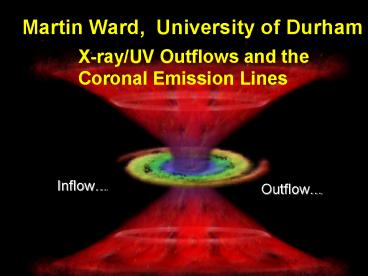X-ray/UV Outflows and the - PowerPoint PPT Presentation
Title:
X-ray/UV Outflows and the
Description:
'May' give information on link between accretion disc and corona and high/low ... Now is a good time to revitalise the study of CLs (near IR hi-res. ... – PowerPoint PPT presentation
Number of Views:220
Avg rating:3.0/5.0
Title: X-ray/UV Outflows and the
1
Martin Ward, University of Durham
X-ray/UV Outflows and the Coronal Emission Lines
2
Outflows are ubiquitous
3
b
4
(No Transcript)
5
Winds in general
- Analogy with jets, they can tell us about bulk
energy transport, and provide an imprint of past
activity - May give information on link between accretion
disc and corona and high/low states of activity
cf. galactic BH systems - Feedback - depends on mass outflow rate, and duty
cycle
For a good review on AGN winds see Crenshaw ,
Kraemer and George Ann. Revs. 194, 117 (2003)
6
Coronal lines as an outflow diagnostic what we
know about CLs
- Very high I.P. (by definition), up to 0.4 keV
(thermal 3 million K) - Sometimes (not always) very broad cf. the
extended NLR profiles - Sometimes (not always) blue shifted peak w.r.t
the NLR profiles - Sometimes they have obvious blue winged profile
(multi-spatial components) - Variability? Not well understood but yes in a
few cases, needs more studies
7
Coronal Line Diagnostics
Table from Oliva et al. (1994)
8
Where are the Coronal Lines Emitted?
9
Murayama and Taniguchi (1998)
10
Where are the CLs emitted? Circinus Galaxy
Sey.2 (Oliva et al. 1994)
11
Up-date on Circinus Sinfoni data Mueller
Sanchez et al (astro-ph Aug. 2005)
Narrow compact Broad spatially extended
12
Chandra X-ray image of Circinus
13
REJ1237264 IC3599, Brandt et al.1995
NLS1
1991.5
An extreme case with FeX, FeXI, FeXIV gt
OIII 5007
14
IC3599 - Grupe et al (1995)see also Komossa and
Bade (1999)
1995.2
1992.1
15
Kinematic information contained in the CL
profiles and shifts
Erkens et al. (1997)
16
RE J1034396 KUG1031398
Puchnarewicz et al. (1995)
17
KUG 1031398
See Casebeer et al. (2006), FUSE data plus
detailed photoionisation models
18
Goncalaves et al (1999), KUG 1031398
19
The Warm Absorber
- At least 50 of type 1 AGN have WAs
- X-ray absorption by ionised gas along our line of
sight - Deep OVII and OVIII edges
- Sensitive diagnostic of the ionisation structure
and kinematics of the gas - Are the UV and X-ray absorbers related? Possibly
diff. phases of gas at same velocity - Where are the absorbers located?
20
Cassidy and Raine (1997)
21
PDS456 the radio quiet analogue of 3C273
evidence for outflows, X-ray/UV/IR CLs
Torres et al (1997)
22
PDS456 The Most Luminous Nearby Quasar A
luminosity normalised NLQSO
- LBOL 1047 erg s-1 , z 0.184
- PDS 456 is radio-quiet, so no jet contamination
(cf. 3C 273) - SUMMARY OF X-RAY
DATA - Outflowing at 0.15c
- If hard X-rays driving outflow, mass-loss rate
10 M? yr-1 - If 10 covering factor, outflow K.E. 1046 erg
s-1 (10 Lbol) - Highly variable in X-rays
- Properties consistent with high accretion-rate
object
23
X-ray Absorption in PDS 456
XMM-Newton RGS
XMM-Newton EPIC
No Iron K? Line
?
Fe XVII XIX?
Fe XXV / XXVI ?
24
Ultraviolet Properties of PDS 456
CIV ?1549 ?v shift -5000 km s-1
?
?Ly? NV
Ly? BAL (14-20,000 km s-1) but no NV or CIV
absorption
HST Spectra of PDS 456 3C273, OBrien, Reeves
and Ward (2004)
25
CIV velocity shifts in Sloan quasars (Richards et
al. 2002)
Dashed ones are recomputed by hand
Blue shift for CIV in PDS456 is 4,000-5,000 km/s
26
Comparison of H? and Ly? profiles in PDS 456
H? black
Ly? red
27
HST Ultraviolet Spectra of PDS 456 NGC 3783
Showing narrow gal. absorption broad intrinsic
absorption which, if associated with Ly?, has
vel. shift 14,000 20,000 km/s
28
Near IR Spec. of PDS456 comp. with 3C273
NGC4151
29
Akn 564 Rodriquez-Ardila et al. (2002)
FeXIII I
30
Concluding Remarks - general
- Winds are important 50 years of trying to
understand accretion and relativistic jets, now
turn of winds - What drives them of all scales how are low and
high velocity winds related? - What switches them on and off?
- Can they tell us something fundamental about AGN
physics and evolution?
31
Concluding Remarks - specific
- CLs may be spatially coincident with the WA
and/or the X-ray soft excess components. - If so they can be used as an additional or proxy
measurement of its properties - They certainly contain information about
kinematics inside the NLR and the SED in the
UV/soft X-ray region - Now is a good time to revitalise the study of
CLs (near IR hi-res. spectra, IFUs and
monitoring with robotic telescopes)
32
(No Transcript)































